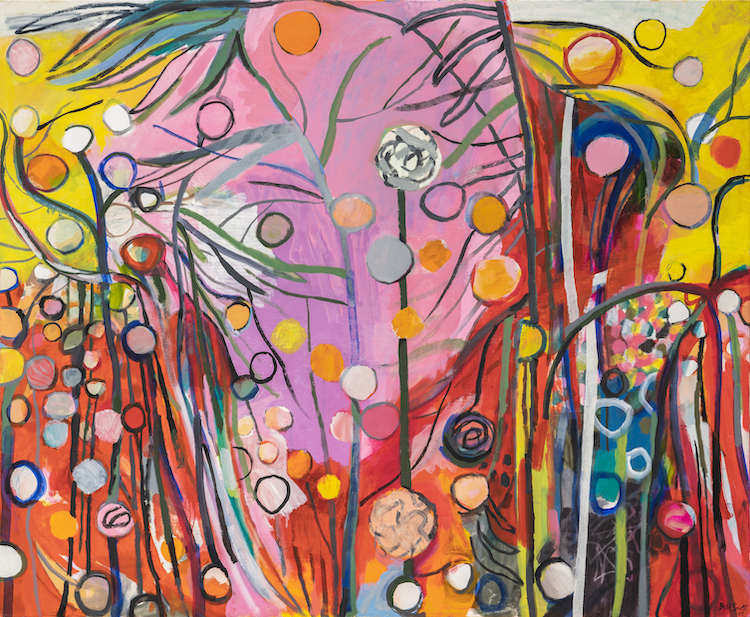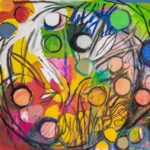by Ted Walsh, 10/5/2023
view Ted Walsh’s full essay HERE.
I once asked Bill Scott how he decides the size of his paintings. He told me it can do with the size canvases he fits up and down the stairs to his attic studio. An answer as clear and gracefully thoughtful as his paintings.
I know Bill from my time living in Philadelphia. My art student years, and then a few more to get my artist’s feet under me. Bill’s house, and studio are the kinds of spaces young artists hope to wind up in someday. Bookshelved walls full of art books. Collection of paintings hanging throughout the house. A really good collection. Sometimes artists’ collections are built of leftover pieces. Stuff you don’t really want to get rid of, so you hang it to keep from cluttering the basement. Not Bill Scott’s collection. He has beautiful pieces gathered over a lifetime. Pieces he admires by artists he admires, and each has a story.
Then there’s the attic studio. Perched above a neighborhood of row house rooftops, like a modern Philly version of a 19th century Paris studio. High ceiling, and skylights diffusing light to a work space with house plants, tidbits of visual influence, sketches, easel, and painting tools. An artwork of a room.
And so, each piece makes the trip upstairs as blank canvas, paint tubes, and ideas. And each comes down a harmony of color, shape, and form. It’s more than just a practical concern. It’s the efficient thought of a true painter. It’s all about the work itself. You just make paintings. You don’t need the verbal floridity. The answers are in the paintings. You don’t ask. You look.
Bill Scott has a solo show this month at Somerville Manning Gallery in Greenville, DE. The gallery is in an old mill building on the banks of the Brandywine Creek. Across a little foot bridge, and up some steps it’s a great gallery to visit. It’s Wyeth country there. The gallery shows work by Wyeth family artists, and artists of the Brandywine tradition. They also show notable modernist work, Wolf Kahn comes to my mind. And they carry an impressive array of contemporary painters too. This show of Bill Scott paintings is up until October 14th.
It’s a show of dancing lines, bright color, and bubbling shapes. The paintings are playgrounds of abstract visual space. Still, the compositions are paced, and well thought. Like all of Bill Scott’s work, you get more out of these paintings the longer you look at them. The slow pleasure of great paintings is too often missed or ignored. Respite from fast media, and art of quick or witty one-liners, it’s a joy to see work that gives you more over time. Like the joyful modernism of abstract jazz.
In these paintings you see the macro and the micro together. The shapes and spaces are somewhat cosmic, but also uncompromisingly intimate. Like the moment you find yourself contemplating the whole universe within the shape of a leaf or a flower.
The Third Week of Spring, smallish, 11 x 14, is held dear and delicate. Like a handful of berries, sprigs, and seeds placed in a dish of pooling color. In Half a World Away, larger, 60 x 72, the shapes take off in a floating and percolating constellation. An array of circles like planets and suns pop within a matrix of jungle shapes, and undulating color washes.
With these paintings, your intuition registers visual space before your brain even knows you’ve seen it. Skillful picture design makes this work. The air of the paintings is composed of overall shapes screened by dancing lines, slices and squiggles, and marble-like circles.
Bas-Relief II, 34 x 34, is a knock out square painting. The undergirding structure is strong. Puzzle-pieced shards of white, yellow, blue, orange, and pink underlay a trelliswork of curving dark lines and circles. It’s centered by a pack of white lines showing gray by way of underpaint. A middleward set dish of wiggling sardines. Very composed, but very free.
Wallflower, 11 x 14, is similarly built, but with more dashing looseness. The lines are chunky brush strokes, and a breath of gray/purple dots puff diagonal across the lower hemisphere of the painting. Winter Flowers, 43 x 39, dances too. But it’s busier. A tangle of lines, circles, leaves, and squiggles are packed tightly over a color structure of airy whites and grays.
There’s a lot within each of these pieces that’s hard to put your finger on, but quite natural to see. And so back to that which you don’t define in words. The thing you just look at. Something like: go ahead, be human, just feel and see. Compose something beautiful. Fit it all within a rectangle of canvas and call it a day.
It’s charming to see Bill Scott paintings in autumn on the Brandywine. Both dreamy, and both romantic. The paintings and the setting fit together well. It’s a region most often associated with the Wyeth and Howard Pyle heritage of painting and illustration. Close by, and similar, is the historic tradition of realism in Philadelphia. A lineage of Thomas Eakins, Cecilia Beaux, Robert Henri, and the like. And these days, a vein of conceptual art is growing in Philly. MFA degree stuff. To the moment, and active along postmodern lines. But in addition to this trendy new and the steadfast picture makers, the region has a great culture of colorism and modernism. Visit the Barnes, or the Woodmere. A history of artists like Arthur B. Carles, Quita Brodhead, and Jane Piper shows strong in art of the region. And there’s Bill Scott. A steward of this lineage. He’s lived, painted, and taught around Philadelphia for his entire life.
Bill is a painter’s painter. I’ve written before about artists who are masters of teaching and mentoring young artists. Bill is one of these constant teachers. He has an eye for talent, and holds honesty about what he knows paintings can be. I have friends who moved to Philly to study with him. And I had the good fortune to run in those circles. Circles of respect, painter for painter.
Make progress on a painting one mark at a time. Think about the bits of paint you add or subtract. Mark up paintings with little pieces of masking tape to note areas that need work. Use sketchbooks. Think formally, and see carefully. Keep looking and adjusting, and don’t go fooling around until you’ve made the painting right.
Fill your house with art that inspires and forms you. Love paintings, and painters; because painting is their being, because that’s what they do. Share what you have, and share what you have made with those who, like you, want to look carefully.

